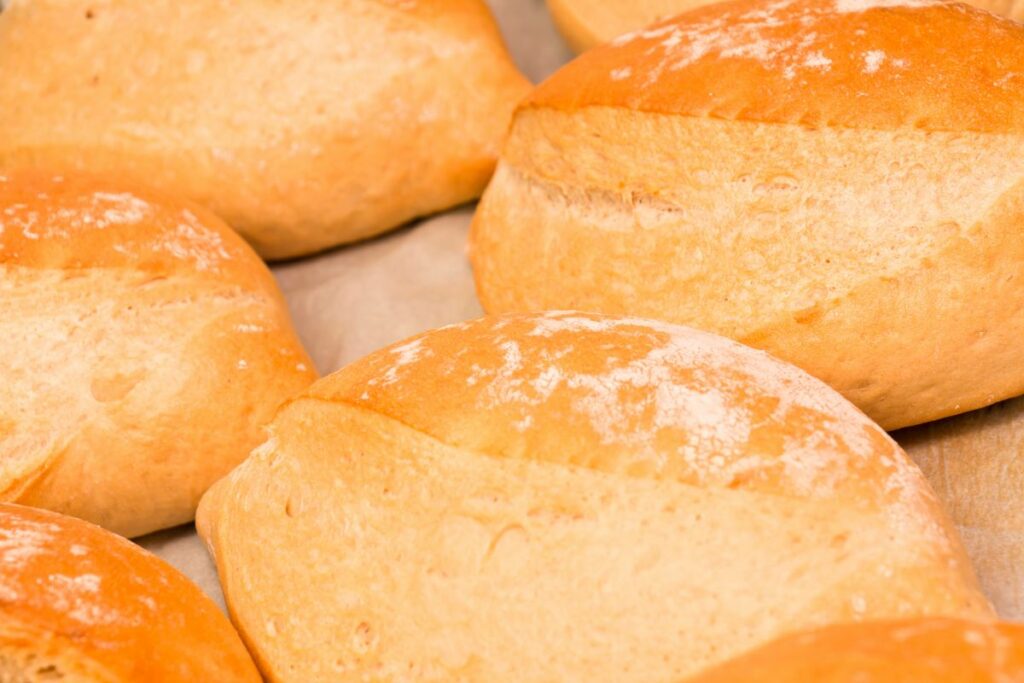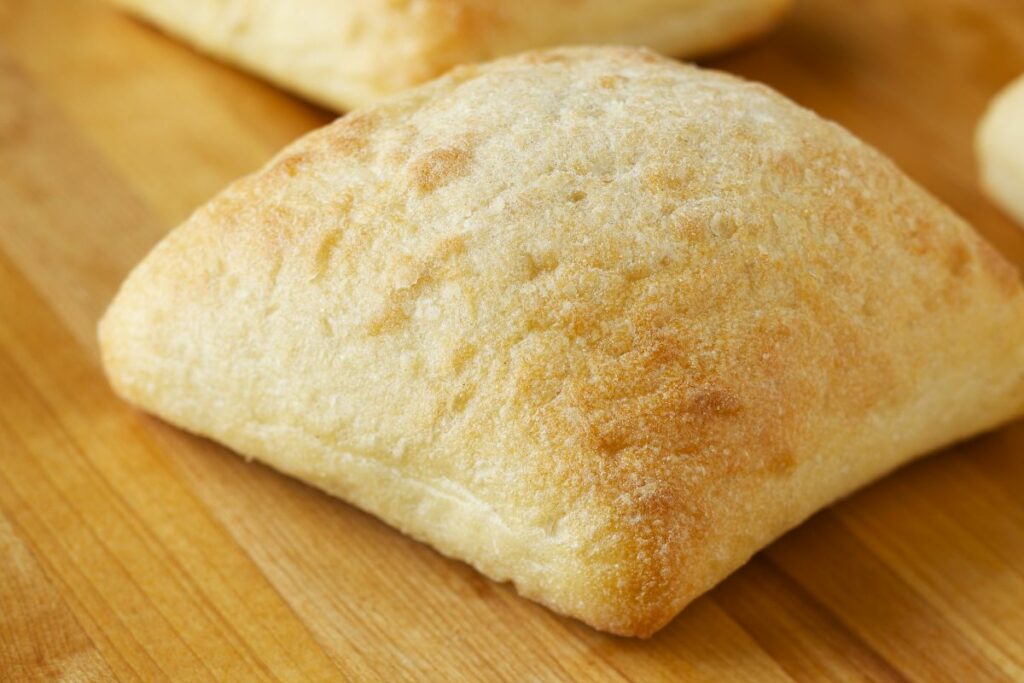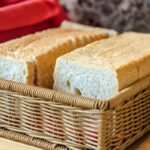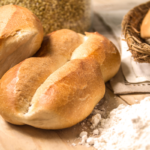So, you have decided to embark on the wonderful journey of making homemade ciabatta rolls. It is so easy to do and with our guidance you should have no trouble at all.

We have all the information you need to make the most perfect ciabatta rolls, from what you are going to need to each step of the bread making process.
What Makes This Recipe Stand Out?
You might be wondering why you should go with this recipe. Well, we are here to tell you why it is the best option on the internet. We have listed a few reasons below:
- Only a Few Ingredients – This recipe only requires a few simple ingredients to make.
- Easy to Make – This recipe is super easy to make, and we found the process relaxing.
- No Special Equipment – This recipe does not require any special equipment.
- Limited Manual Work – You only have to manually do work for about thirty minutes.
- Delicious Bread – With this recipe you will make the most delicious ciabatta rolls.
This ciabatta recipe is much quicker than many others you will see on the internet. The flavor of this bread is really second to none.
You will not be able to stop eating these delicious bread rolls. You have got to love a recipe that is easy to follow. Even an amateur baker should get along well with this recipe at their side.
What Is A Biga?
A biga, which is sometimes known as a poolish, is a preferment which is often added in ciabatta bread dough. It is used to add complexity to the flavor of the bread.
It is most often used in specific types of breads that have open crumbs, some examples include ciabatta rolls, pizza, focaccia, and baguettes.
The method we are going to use in this recipe does not include a biga, but the effect that we get is quite similar to what you would get if you used a poolish or biga.
Some even say that the results you get by adopting our long cold fermented ciabatta bread dough.
Is It Beneficial To Use Cold Fermented Dough?
So what makes our cool slow fermentation process so good? Well, we have found that this method results in a better gluten structure. When this happens, there are more formations of open crumbs and large bubbles.
When dough gets fermented at a low temperature, the yeast will make carbon dioxide and other molecules at a much more steady and tempered rate.
Because the fermentation process takes much longer than it usually would, you get a more complex series of flavors.
What Ingredients Are You Going To Need?
Baking requires a set of ingredients in very specific quantities. Which is why we have listed everything you need in order to make a batch of delicious ciabatta rolls below:
- Flour – You are going to need about two and a three-quarter cups of flour.
- Water – You will need about one cup and three tablespoons of water.
- Yeast – You will need one teaspoon of yeast for this recipe.
- Salt – You will need one teaspoon of salt to make your ciabatta loaf.
With these ingredients, all you need is some instructions, and you should be well on your way to making the most delicious fresh ciabatta loaves.
Step-By-Step Process To Make Ciabatta Rolls

With all your ingredients in hand, you can now start putting everything together to make your ciabatta rolls. Do not worry, it is so easy to do!
So, if you are scared, don’t worry. We are here to guide you through the process. Let’s get started!
1. Get Your Dough Ready
Before you can do anything, you need to get your dough ready. So, start off by adding the following ingredients to a clean bowl: Water, Salt, Yeast, and Flour.
Combine all the aforementioned ingredients together, ensuring that there are no bits of dry flour which have not been incorporated. Once you are done, you should have a somewhat smooth and homogenous dough on your hands.
2. Allow Your Dough Time To Proof
Using either a cloth or plastic wrap, cover your bowl and allow it to rest at room temperature for about two hours. Once this time has elapsed, take your bowl and place it in the refrigerator for about twenty-four hours.
You can even use your dough after five days of refrigeration. To get the most delicious ciabatta rolls, we recommend that you allow your dough to proof for between twenty-four and seventy-two hours.
3. Fold And Stretch Your Dough
For this step, you need to take your ciabatta dough out of the refrigerator. At this point, the gluten strands in the dough should be well-developed.
This means that your next job is to improve the structure of your dough so that it can hold a bunch of bubbles in it.
So, the next step is to stretch and fold the dough. Dip your fingers in a little bowl of water and pull the dough and fold it back down on itself.
Rotate your bowl about ninety degrees and repeat that motion again. Continue doing this until four sides have been stretched and folded. Do this again three times in every half an hour.
What should you do if your dough is sticky? You need to bear in mind that this type of dough is very wet and sticky. The majority of bread dough will have a sixty percent hydration, while ciabatta dough has eighty percent hydration.
It is for this reason that the dough will not be kneaded as it usually would be. Instead, you allow the dough to ferment using the stretch and fold method that we spoke of before.
4. Divide, Shape And Proof Your Ciabatta Dough
After about two hours and three sessions of folding and proofing, it is time for you to pour your dough into a clean yet floured work surface.
While you are doing this, it is essential for you not to deflate the bubbles that have formed while you do this. You can sprinkle some flour on top of the dough so that it is not as sticky.
The best way to shape your ciabatta rolls is to stretch the dough from underneath. The objective is to get your dough in a rectangular shape and then divide the dough into a square, rectangle or any other shape that works best for you.
It is best for you to divide the dough into about six equal sections.
Each of your sections should be placed on a clean yet floured work surface. Sprinkle your sections on your dough and cover them with a plastic film for a little while.
Allow them to sit covered like this for about half an hour for the final proofing.
5. Bake Your Ciabatta Bread Rolls
Once your dough has proofed for a further thirty minutes, take the plastic wrap off and place the dough onto a sheet that is lined with baking paper.
You can use cooling racks for this step if you like, we have seen good results using cooling racks. To make the transference easier, you could use a bench scraper.
With that, your dough should be read to go into the oven and bake. Your oven needs to be preheated for baking.
So make sure that you have set it to 425 degrees Fahrenheit and allowed it to heat up before you put your dough in the oven.
Place your parchment paper on a preheated baking treaty or baking stone, and then spray your bread with a little water. With that, close the door of your oven and allow your bread to bake for about fifteen minutes.
Once fifteen minutes have gone by, turn the temperature down to about 375 degrees Fahrenheit and allow your ciabatta loaf to bake for a further five to eight minutes.
Remember, just because your bread looks done in fifteen minutes does not mean that it is. An additional five to eight minutes draws out the flavor and gives you that perfect crust that ciabatta rolls are known for.
Tips For Making The Best Ciabatta Rolls

If you want to ensure that your ciabatta rolls will turn out perfectly, then there are a few tips that you absolutely need to keep in mind. We have listed everything you need to know below:
- Steam is Key – Getting steam in the oven while you are baking is essential for getting the perfect crispy, crunchy crust. You can do this by spraying some water in the oven a few minutes before you put the dough in the oven. This allows you to create the perfect steamy environment for your bread. You can also place a baking pan on the bottom of the oven and pour a little water in it. This will create steam for your ciabatta rolls.
- A Bench Scraper Will Save the Day – If your dough is sticky, like it inevitably will be, you may find that using a bench scraper will make your life a lot easier. The eighty percent hydration in this dough will make it very sticky, so use flour and a bench scraper to ensure that you easily transfer the dough to where it needs to be.
- Preheat the Oven – it is essential for you to preheat your oven to 425 degrees Fahrenheit. The high temperature is key to creating the perfect ciabatta dough. It causes the crust to become crispy, which is exactly what we love about this delicious type of bread.
- Cold Fermented Dough Makes Tasty Bread – The cold fermented dough method is easy to do, and it can improve the flavor of your bread as well.
With these four tips on your mind, you should be well on your way to creating the most delicious ciabatta bread rolls you have ever had the pleasure of consuming.
Final Thoughts
We hope that you have enjoyed reading this article and learning about how to make the best and most delicious ciabatta loaves.
This is so easy to make, this delectable Italian bread. You will certainly enjoy eating it fresh as part of a salad or another amazing dish.
Regardless, this bread is best enjoyed fresh, so make sure to bake some ciabatta rolls at home. You will love each and every bite!
Frequently Asked Questions
In this section, we are going to answer some of your most frequently asked questions surrounding homemade ciabatta rolls.
If your yeast is exposed to cool temperatures, there will be a slow production of carbon dioxide. As such, by refrigerating your dough, you allow the yeast to leaven at a much more slow and steady pace.
When this happens, you end up with a more complex and flavorsome ciabatta roll. We have found that the dough is more flavorsome using this method of fermentation.
The stretch and fold method is essential for two reasons. Firstly, it allows the gluten to layer and get stronger within the dough. Secondly, it also redistributes any heat that is inside the dough.
If you store your ciabatta rolls properly, they can last up to three days. As long as the temperature is not too high. If you want your bread to last a long time, you need to make sure that your rolls are stored in a bread box storage back or til foil.
Just make sure that you only store your bread away like this once the rolls have thoroughly cooled down.
You might think that storing your ciabatta rolls in the fridge is a good idea, you would be wrong.
Storing this kind of bread in the fridge will dry them out and cause the bread to go stale much faster than they would if you were to store them at room temperature.
You actually can freeze your ciabatta rolls, and they will last longer. Simply wrap your rolls in aluminum foil or a plastic freezer bag so that the bread does not get freezer burn.
Your bread will last a long time, but it will maintain its quality for a month.
Yes, you can easily double this recipe, or even triple it if you feel the need. Just remember to keep your ratios correct. If not, you may struggle to get the best results.
Yes, ciabatta rolls are vegan-friendly. If you don’t mind eating yeast, which is technically a living organism.
But this recipe only includes four ingredients which are as follows: Flour, Yeast, Water, and Salt. All of these ingredients are vegan-friendly.
This type of bread is one of the most popular breads in the world. The nutrients it contains include fiber, sodium, carbohydrates, vitamins and more.
It is a healthy bread which can reduce the risk of contracting cardiovascular diseases, preventing type-two diabetes and, reducing the risk of several other unpleasant illnesses.
Ciabatta rolls are most often used in Italian cuisine. In particular, they are used for making paninis. This type of sandwich can include a whole host of fillings.
Some of which include veggies, cheese, meat, and more. It really is the most delicious bread that you are bound to love.
The most healthy breads you can eat are as follows: Sprouted Grain, Sourdough, 100% Whole Wheat, Oat Bread, Flax Bread, 100% Sprouted Rye Bread, and Healthy Gluten-Free Bread.
Typically, this type of bread is toasted, but because the crust is quite crunchy, you should not do so for very long.
We recommend that you toast your ciabatta rolls at about 350 degrees Fahrenheit for between two and three minutes in a toaster oven. This will toast your ciabatta rolls to perfection.
This rustic bread is a staple in Italian bakeries. It has a delicious thin crust and a soft interior, which many people love. It is used in many different ways.
But is it easy to digest? Well, it actually is light and easy to digest, which is down to the high water content and lengthened leavening time.
Bread such as baguettes and ciabatta rolls are a few foods which are certified as having a low FODMAP by Monash University, founders of the low-FODMAP diet.
The best way to soften a ciabatta roll is to wrap it in foil and warm it up in an oven at 350 degrees Fahrenheit for about twenty minutes.
This may seem like a long time, but we can assure you, this is the best way to soften your ciabatta rolls.
- How To Reheat A Cheesesteak - November 5, 2023
- What Are Three Must Have Kitchen Knives? - September 22, 2023
- How To Protect Edges Of Pie Crust - June 15, 2023








